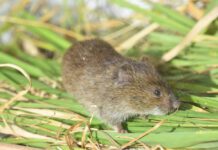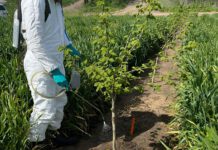Integrated pest management (IPM) in hazelnuts starts with monitoring and identifying pest pressures for significant pests, assessing the presence of natural predators in the orchard, and then choosing the most selective, least impactful approach to managing these pests based on economic thresholds.
Identify and Monitor
Learn to identify pests that are causing damage (extension agents are a great source for help in identification.) Learn the life cycle of pests, when to disrupt the cycle and how best to do that.
Once you have identified pests, such as the filbertworm moth, check for the telltale band of iridescent copper coloring across their wings, monitor the moth numbers using pheromone traps. According to Oregon State University (OSU) Extension, filbertworm moths begin flight and damage as early as late May in the Pacific Northwest. There may be two generations of moths per year, and damage to nuts can continue through fall harvest in September and October.
Begin monitoring with traps by late June. Place traps in the upper third of the tree canopy. Use four traps for the first 10 acres. Add another trap for each additional four acres. Do weekly trap checks. Once pests are detected, increase trap checks to twice a week until it is time to use pest control tactics such as pheromone disruption or pesticides.
Evaluate
Results from monitoring will help answer questions such as, “Is this the pest that’s causing damage?” Filbertworm damage is obvious since the worms leave small exit holes in nuts. If the worm hasn’t yet chewed its way out, inside the shell you’ll find frass (worm poop), a damaged kernel and a light-colored worm with legs— not to be confused with filbert weevil larvae, which are cream-colored, less worm-like, more grub-like and legless.
The next questions to ask: “Is there enough evidence of the pest, and is the damage extensive enough that I need to take action?” A few filbertworms aren’t worth the cost of spraying pesticide, but if the evidence points to a larger infestation, it’s time to take action. Choose the preventative measure that will cause the least damage to beneficial insects to maintain their presence and prevent secondary pest issues.
Prevention Where Possible
Take preventative measures whenever possible. For example, paint trunks of young trees with white paint to deter Pacific flatheaded borers. Although the paint doesn’t kill borers, it does irritate them, which will encourage them to move on to a less hostile environment to lay their eggs. Adult borers are red bronze with copper-colored spots on their wing covers. They are a fairly large insect at a quarter-inch to half-inch long with large eyes.
Pacific flatheaded borders have good eyesight and home in on trunks or bark with sunscald or physical damage from equipment. The Pacific flatheaded borer larva’s head is flat and large in comparison to its 0.5-inch body. Female borers lay eggs on the bark of trees. Borer larvae burrow into the wood and feed on the cambium. The grubs can girdle and kill trees.
Filbertworm pupa overwinter in grass or mulch. Raking around trees during winter exposes the pupae to deadly freezes. The Oregon Hazelnut Commission funded an OSU study which is looking at the benefits and drawbacks of winter flailing to control filbertworm.
Carefully select preventative treatments, but don’t put all your nuts in one basket. Chances for success increase if you use more than one tactic. When chemical pesticides become necessary, give preference to the most selective options.
Set an action threshold – if two to three filbertworm moths are showing up in your traps, for example, or five moths in any single trap, then you know it’s time to act. If pest populations remain low or decrease, further treatments may not be needed. If pest numbers increase past the threshold number, try another IPM tool.
Preserve Beneficials
To take IPM a step further, while monitoring pests such as filbert aphids and hazelnut aphids (filbert aphids are pale white or yellow, hazelnut aphids are darker), also monitor for beneficial insects such as lacewings and ladybugs, also called ladybirds. Both insects have a voracious appetite for aphids. Learn to identify ladybug larvae, also called ladybug dragons or ladybug lions. They eat even more aphids than the adults. Like most insects, the larvae of ladybugs don’t look like the adults. Ladybug larvae look more like tiny crocodiles. They are elongated, spiny and dark with bright stripes or spots ranging from yellow to orange and red.
If you have a healthy balance of pests and beneficial insects in any given year, you may not need to spray, or you may not need to spray as often, saving money in both labor and chemical costs.
“For IPM, there’s a threshold number for the bad bugs we have as an industry,” said Jeff Newton, farm manager for Crimson West/Christensen Farms in McMinnville, Ore. “Take aphids, for example. We count them and come up with an average per leaf.”
OSU extension offers the following guidelines for aphid counts: Start sampling when leaves have fully developed. Take samples every other week, three terminals per tree is ideal. Look at the newest fully expanded leaf on each terminal. Sample 20 trees for each two to four acres of orchard. Take action when you count an average of 20 aphids per leaf in April; 30 aphids per leaf in May; 40 aphids per leaf in June and July.
“If we get too many aphids, we spray,” Newton said. “At the same time, we’re watching the predators. If you don’t have any predators, you’re probably going to spray a little sooner.”
How can you tell which are the “bad bugs” and which are the “good bugs?” When looking for natural predators for aphids or spider mites, for example, one rough rule of thumb that Newton follows is the speed at which an insect moves.
“Predators run around fast,” Newton said. “If it’s running around, it’s a good guy. Predators have to be fast enough to catch their prey. The bad ones just sit there sucking on the leaf.”
Spider mites and their predators are so small that it generally takes a magnifying glass or microscope to do an accurate count, although they aren’t too small for ladybugs to see. Ladybugs and their larvae eat mites and scale insects as well as aphids.
















